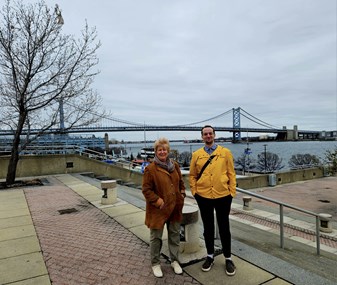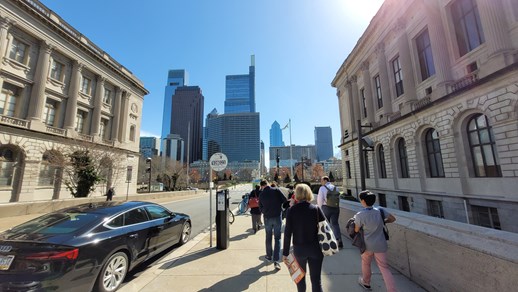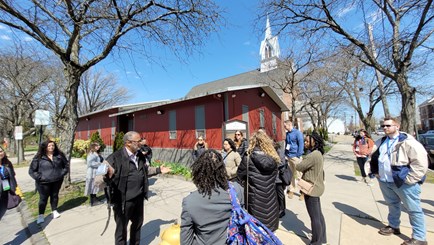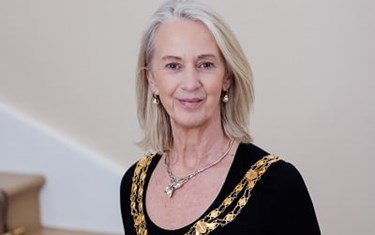
Simeon Shtebunaev is the RTPI's Young Planner of the Year.
Philadelphia’s name translates to the “city of brotherly love”, proudly etched on information panels across the city. Indeed, the “city of firsts” and the host of the APA National Planning Conference 23 is dotted by Historical Markers (an initiative of the Pennsylvania Historical and Museum Commission) at every street, noting historic events, buildings and people. Civic pride is clearly a priority within the city’s planning, something the Levelling Up agenda in the UK aims to encourage. The Penn statue rests on top of City Hall, overseeing the development of its eponymous plan, the grid that defines Center City and much of American Planning. Penn’s quaker ideals of religious, racial, and gender equality tested throughout the years, have made their way into the urban fabric, not less in the famous Love Square.
So how does brotherly love manifest in the city? M. Scott Peck writes that love is “the will to extend one’s self for the purpose of nurturing one’s own or another’s spiritual growth.” A notion adopted by bell hooks, expanding on that “To truly love we must learn to mix various ingredients - care, affection, recognition, respect, commitment, and trust, as well as honest and open communication.” (Bell Hooks, All About Love: New Visions). In my own experience, the same notions are prerequisites not only to love but to meaningful community engagement. Philadelphia is challenged by its own identity - but in the projects we saw - the historically unloved, the denizens of China Town, the racially marginalised, the poor people, are given a wider prominence in planning processes. American politics and by extension planning have always been driven by a debate on equality and more recently, equity. As a researcher focusing on the power dynamics between citizens and planners, advocating for youth inclusion, I was pleasantly surprised to discover how embedded community engagement practices are within planning.
 The city of Philadelphia’s citizen planner programme led by the Citizen Planning Institute, is an inspiring example of how community members can be involved. The institute is part of the The City of Philadelphia Fund, a non-profit fund set up by past mayors and supported by the city. The programme recruits and trains cohorts of community leaders, spread out geographically, biannually. It aims to prepare and empower communities by demystifying the planning processes and system and building a network of partners across the city. There are over 700 graduates from all 130 neighbourhoods of the city, a strong network of planning-literate community leaders. The Citizen Planning Institute is the education and outreach arm of the Philadelphia City Planning Commission. When was the last time your local planning authority considered an outreach program?
The city of Philadelphia’s citizen planner programme led by the Citizen Planning Institute, is an inspiring example of how community members can be involved. The institute is part of the The City of Philadelphia Fund, a non-profit fund set up by past mayors and supported by the city. The programme recruits and trains cohorts of community leaders, spread out geographically, biannually. It aims to prepare and empower communities by demystifying the planning processes and system and building a network of partners across the city. There are over 700 graduates from all 130 neighbourhoods of the city, a strong network of planning-literate community leaders. The Citizen Planning Institute is the education and outreach arm of the Philadelphia City Planning Commission. When was the last time your local planning authority considered an outreach program?
Another interesting example of community engagement can be seen in the Reimagine Benjamin Franklin Parkway project, currently undertaken by Design Workshop and the Philadelphia Parks & Recreation (PPR), the Office of Transportation, Infrastructure, & Sustainability (OTIS). The project aims to engage all citizens to create a more walkable and accessible parkway. We attended a workshop focusing on the youth engagement process, facilitated by YEP! Youth Engagement in Planning. YEP! are a non-profit led by planners and aiming to educate young people about planning and civic engagement and mentoring those interested in exploring a career in planning and related fields. They also provide free resources geared towards town planners and facilitation and community engagement services. Check them out! In Philadelphia this engagement is focusing on the way that young people in the area want to utilise the parkway and crucially comes at the early stages of creating planning strategies, in a proactive approach.
 Community engagement and specifically youth inclusion in the process seem to be part of the planning process in a much more systematic way. Writing up my PhD’s recommendations on teenager inclusion, I saw some of them play out in real life! The historic police headquarters, a building mired in controversy, is the subject of a sensitive exercise commissioned by the Philadelphia Department of Planning and Development - the Roundhouse Futures. With a $200,000 budget and working with artists, community members, youth and other partners, the project aims to understand the role of the building in the future of Philly and record it. Working with Connect the Dots and Amber Art and Design, the project team has engaged OnesUp, a youth economic empowerment agency, to recruit and work with young people as community consultants. The final project report recommends two actions: property disposition and nomination to the historic landmark, but crucially it records the public consultation and frames any future action with the building through the lenses of equity and inclusion. The project demonstrates the ability of planning departments to tackle sensitive issues and build community trust where one has been broken.
Community engagement and specifically youth inclusion in the process seem to be part of the planning process in a much more systematic way. Writing up my PhD’s recommendations on teenager inclusion, I saw some of them play out in real life! The historic police headquarters, a building mired in controversy, is the subject of a sensitive exercise commissioned by the Philadelphia Department of Planning and Development - the Roundhouse Futures. With a $200,000 budget and working with artists, community members, youth and other partners, the project aims to understand the role of the building in the future of Philly and record it. Working with Connect the Dots and Amber Art and Design, the project team has engaged OnesUp, a youth economic empowerment agency, to recruit and work with young people as community consultants. The final project report recommends two actions: property disposition and nomination to the historic landmark, but crucially it records the public consultation and frames any future action with the building through the lenses of equity and inclusion. The project demonstrates the ability of planning departments to tackle sensitive issues and build community trust where one has been broken.
Another example of meaningful community engagement was demonstrated in the Southbridge neighbourhood of Wilmington, Delaware, where the local black community has been engaged in a project to establish a Community Development Corporation (CDC) and create the Southbridge Neighborhood Action Plan (SNAP). Situated in a flood-prone plane, a wetland park project is set to deliver flood defences, tackle the sewage issue plaguing the area and lead to rise in land prices. Telling the story of the engagement, Hanifa Sabazz, chair of Southbridge CDC and past Councillor in Wilmington, demonstrated how an early community intervention in planning policy processes can help capture the increase in land values. The corporation is delivering improvements - from community-led housing developments to rehab and beautification programmes for the existing housing stock. We were shown around the neighbourhood by Rev. Powell, welcomed by the tightly knit community which has had its fair share of conflict in the past. In the church hall we stumble upon the lunch meeting of community elders, and we are told about a shoot-out which happened recently in the vicinity. Southbridge’s action demonstrated that when planners, consultants and communities work together, a framework can be established which can empower citizens in the planning process.
There are many preconceptions that as someone who had never visited the United States I had to reconsider. Certainly, from lack of recycling schemes to fuel-hungry cars, there is a lot to be questioned about the American attitude towards the climate urgency and it left me worried about our planetary future. However, there is a lot to be learned as well about the way civic pride is interpreted in including citizens in the planning of cities and how financial resources are used to empower those being consulted. A strong community-led planning system is bound to start tackling the issues of climate change, as seen in the Southbridge area where the tidal defences, retrofitting properties and sustainable transportations were issues intrinsically linked to racial justice.


